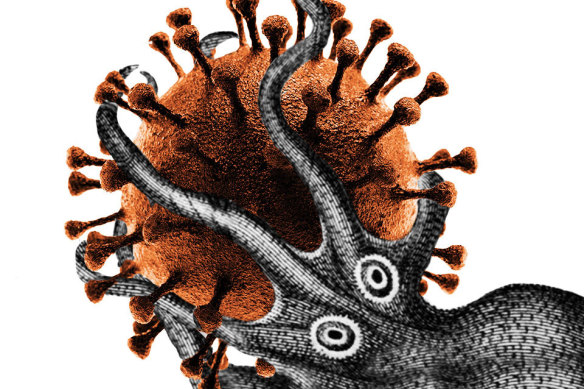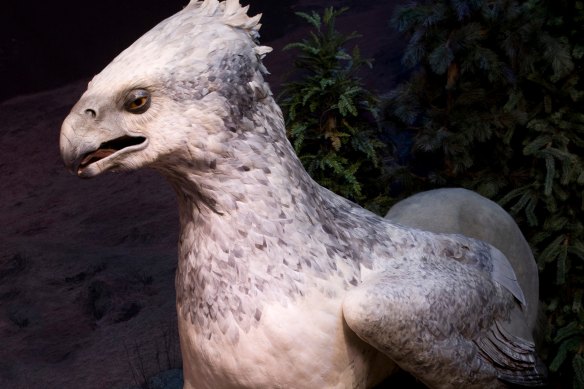Two years ago, learning the Greek alphabet was enough to help you keep track of new COVID variants as they spread around the world: Beta, Delta and Omicron all made headlines as they emerged.
But as Omicron has evolved into more than 650 sub-lineages, each denoted by their own string of letters and numbers, it’s become harder to keep track of the names.
Enter the kraken – a giant squid who symbolises the XBB.1.5 variant estimated to make up 28 per cent of cases in the United States – and a name already adopted as an unofficial moniker by Bloomberg and The New York Times.
The kraken COVID variant is dominating infections in the US but has only been found in limited numbers in Australia. Credit:Kathleen Adele
Canadian evolutionary biologist Ryan Gregory started naming Omicron variants after mythological creatures last year. His list of 20 also includes the serpent king Basilisk (BA.2.3.20) and the 100-eyed giant Argus (BJ.1), and has been embraced by many media organisations around the world – and some scientists.
The World Health Organisation has resisted the trend – it is sticking with the Greek letters and reserving its naming rights until a variant exhibits dramatically different behaviours to its relatives.
But for Gregory, it was unrealistic to use terms such as ‘BA.2.75.2’ and expect the public to follow. He compared it to using the evolutionary group ‘mammals’ and Latin species names.
Few people would know what a ‘Phascolarctos cinereus’ is, Gregory said.
“But if I said ‘koala’, most people would know what I meant. ‘Koala’ is not a formal scientific name, it is a common name… We don’t have common names for every species that has a scientific name, [but] we do need to be able to talk about the most important ones in an accessible way.”
He said the global take-up of his mythological nicknames, particularly the kraken, showed people wanted information about variant evolution to be more widely accessible – “especially as we are seeing guidelines, travel policies and appeals for genomic surveillance from top health officials on the basis of new variants continuing to evolve and spread.”
Associate Professor Stuart Turville from the UNSW Kirby Institute, who researches COVID variants, said Gregory’s new naming trend had functioned as a positive reminder that the virus remained in the community.
“I think it’s bringing a conversation about variants into popular culture and common conversations, and keeping the communication about variants moving forward,” he said.
But there were reasons the World Health Organisation had not jumped on board. “Although they are mythological names and easy to talk about, I think there is a concern it might be [an overemphasis],” Turville said.
“From [the WHO’s] correspondence, they don’t want to move to another name beyond Omicron unless there’s a significant shift in how the virus is tracking.”
As it stands, all the new variants – which are forms of Omicron – are yet to significantly diverge in how they enter the body and grow. Omicron lineages are well-known to target cells of the upper respiratory tract, where previous lineages like Delta targeted both the upper and lower respiratory tract.
The XBB (gryphon), XBB.1 (hippogriff) and XBB.1.5 (kraken) variants, for example, are a grandparent, parent and sub-lineage respectively.
The hippogriff variant is the parent of the more infection kraken but there’s little difference between them genomically.
While kraken has become more dominant because it can stick to cells better than its half-eagle-half-horse predecessor, there’s only one amino acid of difference between the two.
“XBB.1.5 may supplant the other variants in circulation because it’s stickier, but it may not necessarily drive a wave or result in greater disease severity,” Turville said. That’s why the WHO wants to take its time before giving it an official name.
There’s also the issue of geography: each jurisdiction from China to the United Kingdom has its own mix of variants.
While the kraken has hogged headlines, the most common variant down under is XBF, which Gregory has symbolised with a part-fish-part-centaur called Bythos. This hybrid has been prevalent in Victoria and is now circulating in NSW and other states.
The dominant Victorian variant gets its nickname from Bythos, a creature part centaur and part fish. Credit:Smithsonian Design Museum
Turville said that XBF exhibited some of the same key changes as XBB.1.5. But in a battle between the kraken and Bythos, the fish-centaur could prove the winner.
“It will take time to get into our population, but if XBF is just as competitive, XBB.1.5 [kraken] may never get traction here,” Turville said.
The next most common in Australia is BR.2, whose mascot is Cerastes, a flexible horned serpent, which has been more common in NSW.
Three-headed dog Cerberus (BQ.1.1) and two-headed dog Orthrus (CH.1.1) are also running around Australia ruining summers one RAT at a time.
Turville said the popular adoption of ‘Kraken’ had brought variants back into the conversation, which was helpful, but the WHO was taking a cautious approach.
“They need to see a seismic shift [in the virus’ behaviour] rather than one that does a little bit of a better job. Like being on a boat full of flares, they don’t want to send one off too early,” he said.
“I think it’s important to talk about COVID in the community, but I get saying ‘let’s pump the brakes on this and have a conversation about the data’.”
Cut through the noise of federal politics with news, views and expert analysis from Jacqueline Maley. Subscribers can sign up to our weekly Inside Politics newsletter here.
Most Viewed in Politics
From our partners
Source: Read Full Article








